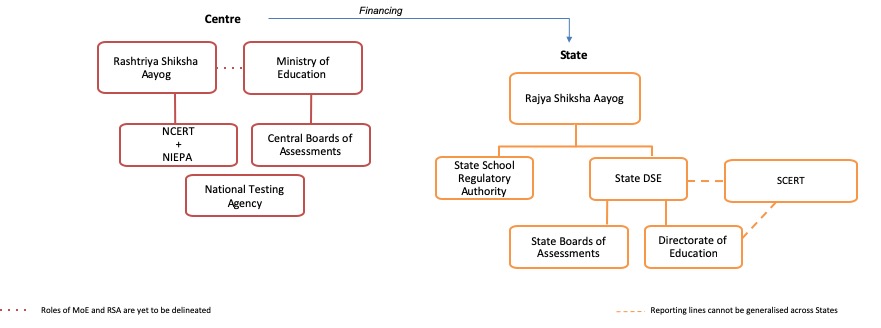The Kasturirangan Committee Report 2019 proposes that “the three distinct roles of governance and regulation, namely, the provision/operation of education, the regulation of the education system, and policymaking, will be conducted by separate independent bodies, in order to avoid conflicts of interest and concentrations of power, and to ensure due and quality focus on each role.”
In our view, separating the regulatory and service delivery functions performed by state school education departments/directorates and creating state-level independent regulators for all schools is the most significant reform proposal in the Report for school education.
As per the Report, each state should set up a State School Regulatory Authority (SSRA) to regulate all schools, public and private, on the same set of minimum standards to assure quality education for all. The revised state education administration structure envisaged under the Report is:
-
the existing Directorate of School Education (DSE) to oversee government schools operations;
-
a newly-formed State School Regulatory Authority (SSRA) to have exclusive responsibilities over rule-making for all schools, public and private, and ensuring compliance;
-
the Department of School Education to be the primary institution for overall monitoring and policymaking (without any involvement in service delivery or regulation).

Enlarge this image
Figure 1: Governance and regulatory architecture of School Education post-NEP 2019
Promise and perils of State School Regulatory Authority
Independent regulation will likely bring competitive neutrality, focus and efficiency. A dedicated regulator for a marketplace of a variety of suppliers, public and private, is an approach increasingly followed in India and several other countries. Conflicts of interest that currently exist between a government service-provider regulating itself and other service providers will be contained. SSRA, as a regulator, will function separately from any government department. As a result, the role played by discretion and quid pro quos in licensing, school recognition, inspections and fee regulation can be minimised. SSRA will be mandated to draft specialised rules only for the K-12 sector. This can encourage a symbiotic relationship where the regulator receives feedback on the efficacy of its rules from regulatees and consumers.
However, an independent regulator makes rules, checks compliance, and enforces the rules. This fusing of powers vests extensive authority in unelected officials. It needs to be countered by assigning the regulator a limited and well-defined mandate and developing an agency design accountable to Parliament/Legislature, regulatees, and parents and children whose interests it is to protect.
Design Elements for an effective State School Regulatory Authority
In this How To Note, we discuss the five design considerations that should go into the setting up of SSRA:
-
Defining clear and narrow objectives: Assessment of SSRA’s performance, metrics to hold it accountable, governance structure, and management processes, all hinge on a clearly articulated objective. This objective should be limited and measurable, and subscribe to the principle of regulatory neutrality.
-
Preparing a legislative framework delegating authority to the regulator: Since SSRA will be at the state-level, the state Legislative Assembly has to pass the Act enabling its creation. Furthermore, the powers relating to K-12 education are currently scattered across numerous Union and state Acts, and enforced by different officers and agencies. These need to be brought under the purview of SSRA to avoid regulatory cholesterol from building up.
-
Structures that ensure independent functioning of SSRA: Independence will insulate SSRA from regulatory capture while making room for guided discretion. Moreover, it will allow SSRA to be held accountable for its decisions. This can be achieved by making appointment process for its Board members transparent, maintaining a balanced and lean Board composition, instituting working processes that incentivise performance, and imposing term limits on Board members to minimise conflicts of interest.
-
Setting up accountability measures for performance via internal separation of functions and information disclosures on processes; and
-
Establishing checks on executive discretion and against the abuse of power: Since SSRA will be formed by fusing quasi-legislative, executive and quasi-judicial powers, fail-safes against potential abuse of power must be instituted. Only its Board must hold rule-making powers. An internal adjudication body, and an external Education Appellate Tribunal are necessary. The rules governing SSRA also must lay out procedural and substantive guidance on applying administrative actions.
The proposal of the Kasturirangan Report to establish an independent SSRA is a promising reform for K-12 education in India because it tackles the key impediments to improvement—conflicts of interest between service-delivery and regulation, absence of accountability, violation of natural justice, and unchecked discretionary power of officers. Embedding the above-mentioned design elements in an SSRA may not guarantee a world-class regulator, but their absence will certainly result in an ineffective regulator that compounds the problems in K-12 education.

